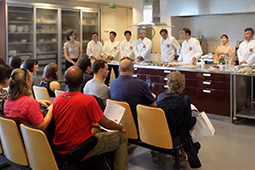March 2022
- PREVIOUS
- NEXT
Sharing the Joy of Wagashi

Wagashi made by Shimizu Toshinaka at the (live-streamed) 18th Japan Cultural Envoy Forum, March 10, 2021 
Shimizu Toshinaka (left) and Mizukami Masashi, then ambassador extraordinary and plenipotentiary of Japan to Spain

Shimizu Toshinaka leads a wagashi workshop in Barcelona, Spain 
Shimizu teaches wagashi workshop participants in Frankfurt, Germany 
Shimizu with wagashi workshop participants in Paris, France

Wagashi (Japanese confectionery) chef Shimizu Toshinaka traveled to Spain, France and Germany for a month in the summer of 2019 as a Japan Cultural Envoy, where he led workshops on wagashi-making and interacted with the local people.

Wagashi chef Shimizu Toshinaka is the Director and Executive Adviser of Ryouguchiya Kasyo, a Japanese confectionery store in Anjo City, Aichi Prefecture with a history of about 300 years. As a Japan Cultural Envoy, from June 15 to July 15, 2019, he organized twelve wagashi workshops in five cities (Madrid, Barcelona, Paris, Strasbourg and Frankfurt) in three European countries (Spain, France and Germany). In each workshop, Shimizu taught participants about wagashi-making, such as how to cook adzuki beans and make anko (sweet adzuki bean paste).
Shimizu says, “In recent years, wagashi has become exceptionally popular overseas following the growing awareness towards healthy food consumption in developed countries.”
While Western confectionery uses animal-based ingredients including eggs and butter, wagashi is made mainly from plant-based ingredients such as rice and legumes thus is low in calories. From the health-conscious to vegetarians, people around the world are increasingly becoming interested in wagashi.
Shimizu wanted people to learn about wagashi in a comprehensive way and promoted his workshops under the theme “Joyful Gatherings to Know, See, Touch and Taste Japanese Confectioneries.”
“During my visits to these three European countries that are famous for Western confectionery, I tried to directly display wagashi’s delight. I introduced how wagashi has a history of more than 1,000 years, how there are over 3,000 kinds of them, and how wagashi designs are traditionally intended to evoke the four seasons. I took this opportunity to present on wagashi’s unique tradition of tasting and appreciating the visual ‘appearance’ alongside the flavor, and on the anko bean paste used in many wagashi being made by boiling adzuki or other beans and adding sugar to make them sweet. I also mentioned the various types of sugar used in Japan. Participants were able to look, touch, and eat the traditional wagashi I made. In some workshops, participants were able to make anko.”
It was hot when I visited Madrid, so I made summer wagashi such as mizuyokan, warabimochi, and kuzumanju, which the participants seemed to really enjoy. These three types of wagashi share a clear, cool appearance and a smooth jelly-like texture. Mizuyokan uses agar made from seaweed, warabimochi uses powder made from the roots of a wild plant called warabi (bracken), and kuzumanju kudzu powder is made from the roots of the kudzu plant (arrowroot)—each owning a distinctive transparency and texture.
Shimizu comments, “What people like to eat in the heat is the same all over the world. In Spain, the participants praised the sweets as ‘delicious,’ one reason being for the sweets’ transparent appearance.”

In France, to emphasize wagashi’s development alongside that of the tea ceremony, Shimizu served neri-kiri wagashi (made with sweetened white beans) with matcha green tea. However, as it was extremely hot (40 degrees Celsius) during his visit to Paris, he avoided serving hot matcha and instead prepared cold brew tea. He says the participants admired how the small wagashi, only a few centimeters long, had Japanese aesthetics condensed in the form of refined colors and shapes. The combination of thirst-quenching green tea and sweet neri-kiri was also popular—Shimizu received similar feedback in Germany.


In Strasbourg, participants included patissiers who have been awarded the M.O.F. title (a national competition for excellent artisans; short for Meilleur Ouvriers de France) including the president of a liquor manufacturer and other industry leaders. Together, they discussed the varieties of sugar in Japan. Shimizu comments, “In Europe, almost all sugar is from sugar beets. However, in Japan, there is also sugar harvested from sugarcanes. The flavor and sugar concentration contrast depending on how it is made, so by using different types of sugar such as refined Japanese sugar, brown sugar and light brown sugar, it is possible to produce wagashi of different sweetness. It could be said that Japan has the best variety of sugar in the world. I was struck by how the president of the liquor manufacturer said, ‘more research on sugar is in need.’”
According to Shimizu, his visits to Europe reminded him that the diversity of wagashi comes not only from the multiple types of sugar but also the rich climate of Japan, which is blessed with ingredients for wagashi such as adzuki beans and kudzu. Shimizu’s experience as a Japan Cultural Envoy has allowed him to see wagashi uniquely different from Western confectioneries. Shimizu affirms the power of Japanese confectionery and is ready to continue spreading the knowledge of wagashi as a part of Japan’s one-of-a-kind food culture.
- PREVIOUS
- NEXT

